Experimental Demonstration of Temperature Sensing with Packaged Glass Bottle Microresonators
Abstract
1. Introduction
2. Materials and Methods
2.1. Bottle Resonators and Tapers
2.2. Analysis of Bottle Resonators
2.3. Experimental Setup
2.4. Package
3. Results and Discussions
3.1. Optical Characterization
3.2. Characterization of the Packaged Bottle
3.3. Temperature Measurements
4. Conclusions
Author Contributions
Funding
Acknowledgments
Conflicts of Interest
References
- Foreman, M.R.; Swaim, J.D.; Vollmer, F. Whispering gallery mode sensors. Adv. Opt. Photonics 2015, 7, 168–240. [Google Scholar] [CrossRef] [PubMed]
- Vollmer, F.; Braun, D.; Libchaber, A.; Khoshsima, M.; Teraoka, I.; Arnold, S. Protein detection by optical shift of a resonant microcavity. Appl. Phys. Lett. 2002, 80, 4057–4059. [Google Scholar] [CrossRef]
- Schweinsberg, A.; Hocdé, S.; Lepeshkin, N.N.; Boyd, R.W.; Fajardo, J.E. An environmental sensor based on an integrated optical whispering gallery mode disk resonator. Sens. Actuator B Chem. 2007, 123, 727–732. [Google Scholar] [CrossRef]
- Zhang, X.; Armani, A.M. Silica microtoroid resonator sensor with monolithically integrated waveguides. Opt. Express 2013, 20, 23592–23603. [Google Scholar] [CrossRef] [PubMed]
- Zamora, V.; Díez, A.; Andrés, M.V.; Gimeno, B. Cylindrical optical microcavities: Basic properties and sensor applications. Photonics Nanostruct. Fundam. Appl. 2011, 9, 149–158. [Google Scholar] [CrossRef]
- Yu, J.; Lewis, E.; Brambilla, G.; Wang, P. Temperature sensing performance of microsphere resonators. Sensors 2018, 18, 2515. [Google Scholar] [CrossRef] [PubMed]
- Ma, Q.; Rossmann, T.; Guo, Z. Micro-temperature sensor based on whispering gallery mode of fiber taper-microsphere coupling system. In Proceedings of the SPIE Volume 7420, Photonics West, San Diego, CA, USA, 2–5 August 2009. [Google Scholar]
- Ward, J.M.; Yang, Y.; Chormaic, S.N. Highly sensitive temperature measurements with liquid-core microbubble resonators. IEEE Photonics Technol. Lett. 2013, 25, 2350–2353. [Google Scholar] [CrossRef]
- Hirayama, N.; Sano, Y. Fiber Bragg grating temperature sensor for practical use. ISA Trans. 2000, 39, 169–173. [Google Scholar] [CrossRef]
- Luan, N.; Wang, R.; Lv, W.; Lu, Y.; Yao, J. Surface plasmon resonance temperature sensor based on photonic crystal fibers randomly filled with silver nanowires. Sensors 2014, 14, 16035–16045. [Google Scholar] [CrossRef] [PubMed]
- Kin, G.-D.; Lee, H.-S.; Park, C.-H.; Lee, S.-S.; Lim, B.T.; Bae, H.K.; Lee, W.-G. Silicon photonic temperature sensor employing a ring resonator manufactured using a standard CMOS process. Opt. Express 2010, 18, 22215–22221. [Google Scholar] [CrossRef]
- Ooka, Y.; Yang, Y.; Ward, J.; Chormaic, S.N. Raman lasing in a hollow, bottle-like microresonator. Appl. Phys. Express 2015, 8, 092001. [Google Scholar] [CrossRef]
- Yin, Y.; Niu, Y.; Dai, L.; Ding, M. Cascaded microbottle resonator and its application in add-drop filter. IEEE Photonics J. 2018, 10, 1–10. [Google Scholar] [CrossRef]
- Louyer, Y.; Meschede, D.; Rauschenbeutel, A. Tunable whispering-gallery-mode resonators for cavity quantum electrodynamics. Phys. Rev. A 2005, 72, 654. [Google Scholar] [CrossRef]
- Zervas, M.N. Optical bottle microresonators: Cleaning-up the spectral mess. In Proceedings of the 14th International Conference on Transparent Optical Networks, Coventry, UK, 2–5 July 2012. [Google Scholar]
- Nemova, G.; Kashyap, R. Silica bottle resonator sensor for refractive index and temperature measurements. Sensors 2016, 16, 87. [Google Scholar] [CrossRef] [PubMed]
- Bianucci, P. Optical microbottle resonators for sensing. Sensors 2016, 16, 1841. [Google Scholar] [CrossRef]
- Senthil Murugan, G.; Wilkinson, J.S.; Zervas, M.N. Selective excitation of whispering gallery modes in a novel bottle microresonator. Opt. Express 2009, 17, 11916–11925. [Google Scholar] [CrossRef] [PubMed]
- Zamora, V.; Herter, J.; Janeczka, C.; Schröder, H. 3D optical microresonators: Laser-assisted fabrication and packaging. In Proceedings of the Micro System Technic Congress, Munich, Germany, 23–25 October 2017. [Google Scholar]
- Chiba, A.; Fujiwara, H.; Hotta, J.-I.; Takeuchi, S.; Sasaki, K. Fano resonance in a multimode tapered fiber coupled with a microspherical cavity. Appl. Phys. Lett. 2005, 86, 261106. [Google Scholar] [CrossRef]
- Zhang, K.; Wang, Y.; Wu, Y.-H. Enhanced Fano resonance in a non-adiabatic tapered fiber coupled with a microresonator. Op. Lett. 2017, 42, 2956. [Google Scholar] [CrossRef] [PubMed]
- Kim, E.; Foreman, E.M.; Baaske, M.D.; Vollmer, F. Thermal characterisation of (bio)polymers with a temperature-stabilised whispering gallery mode microsensor. Appl. Phys. Lett. 2015, 106, 161101. [Google Scholar] [CrossRef]
- Zhi, Y.; Meldrum, A. Tuning a microsphere whispering-gallery-mode sensor for extreme thermal stability. Appl. Phys. Lett. 2014, 105, 031902. [Google Scholar] [CrossRef]
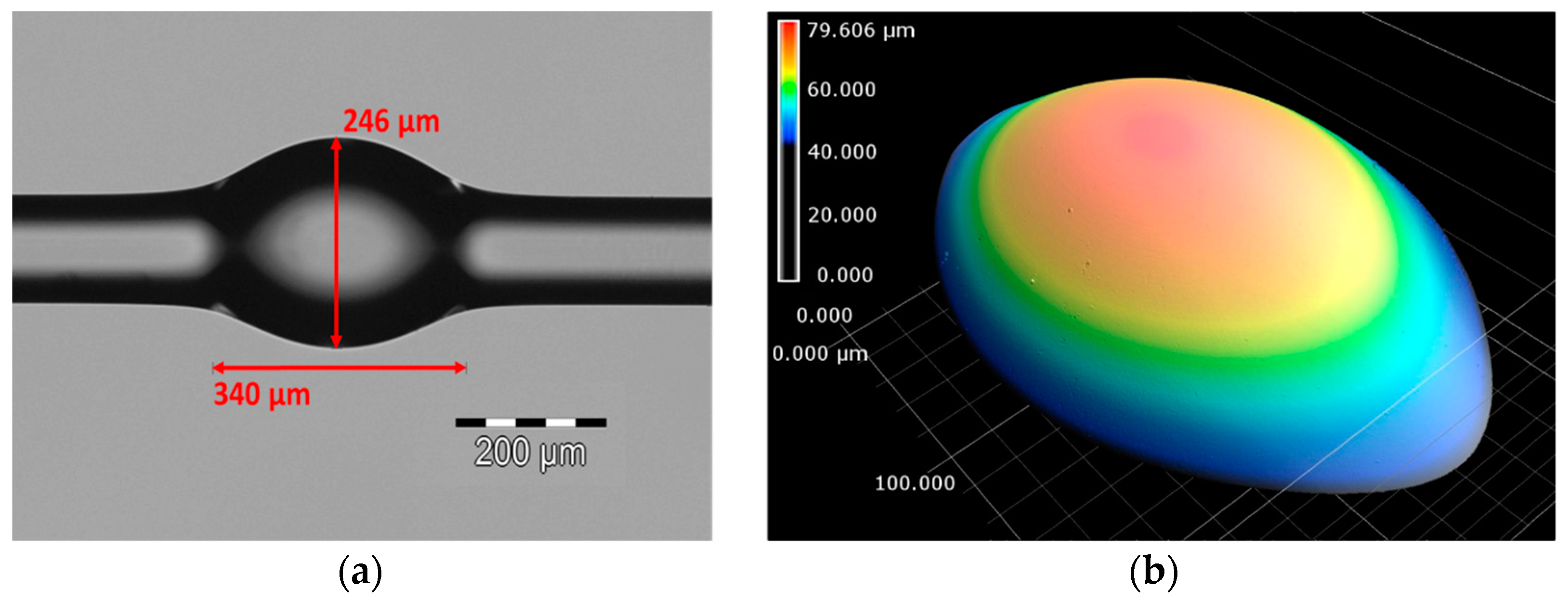
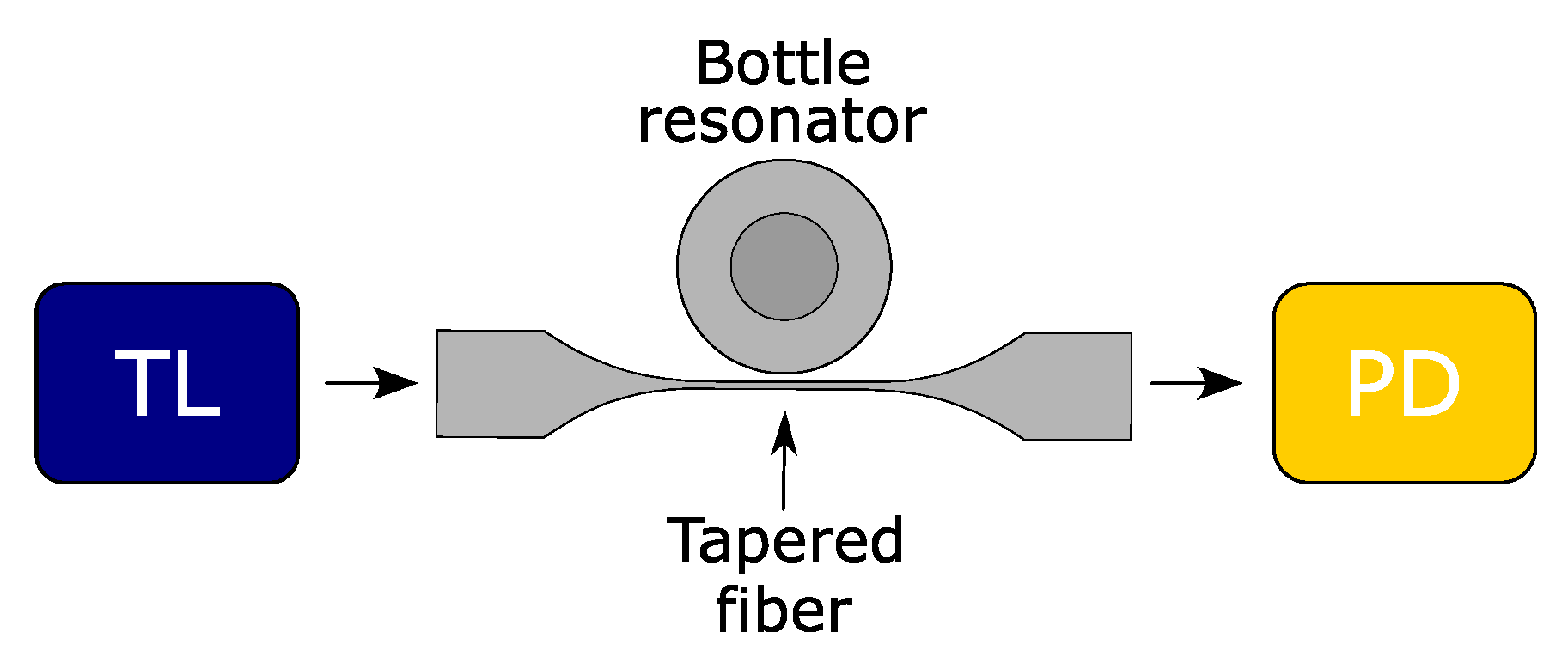


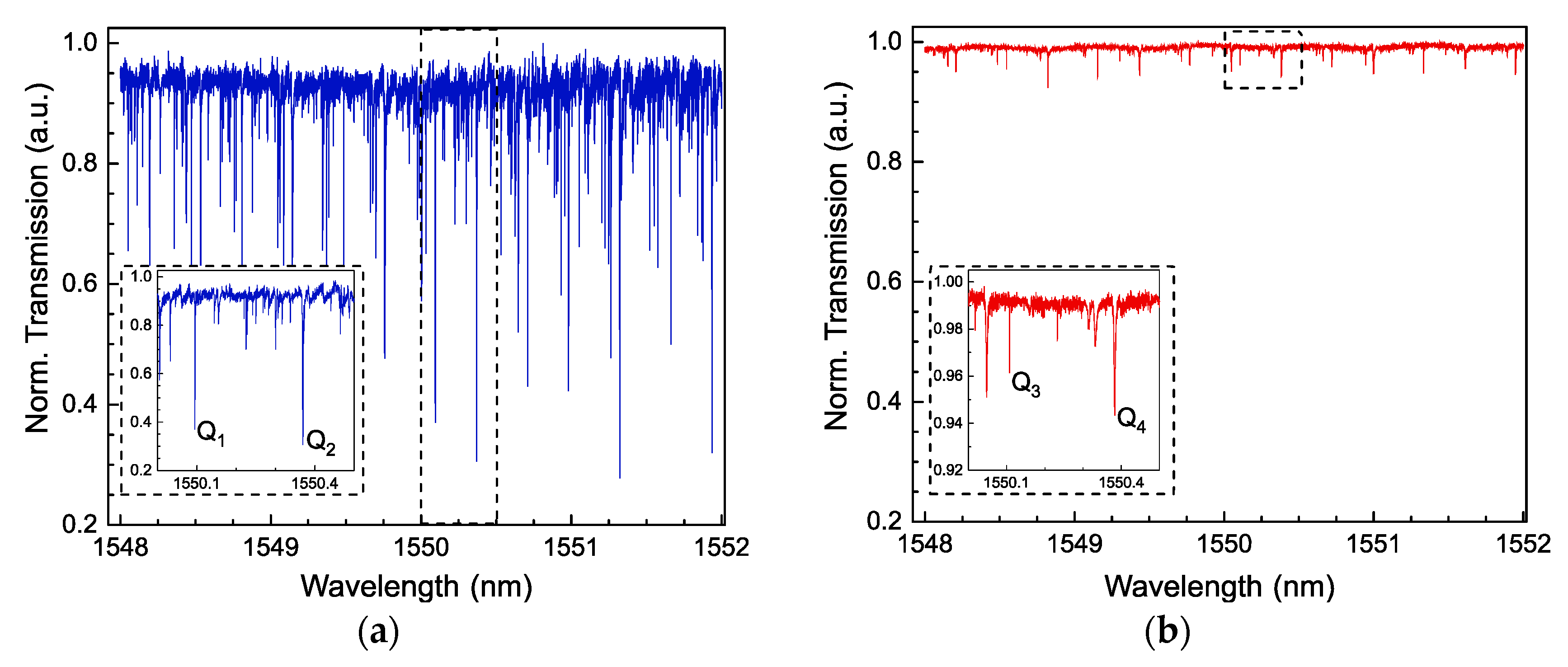
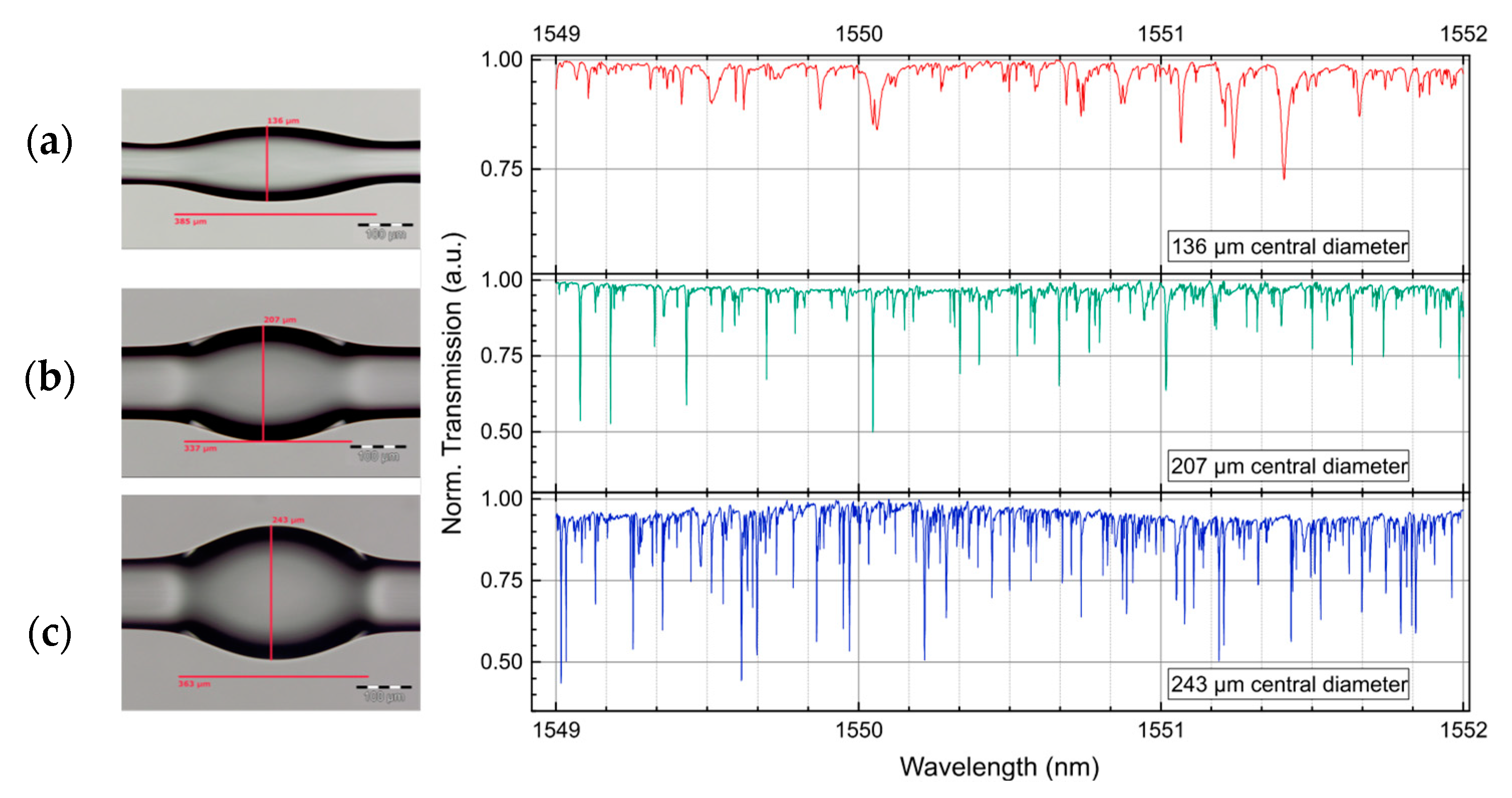
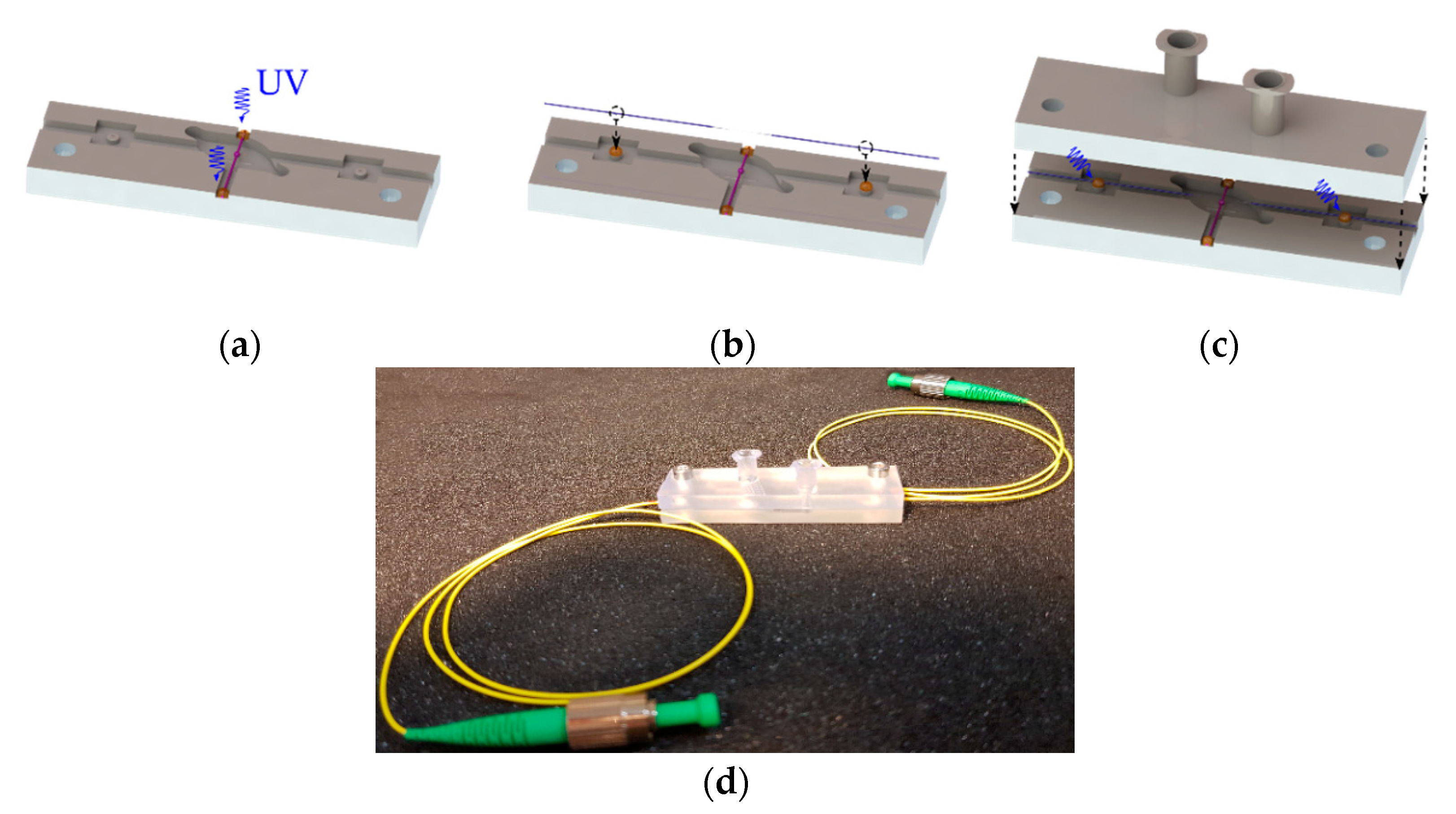
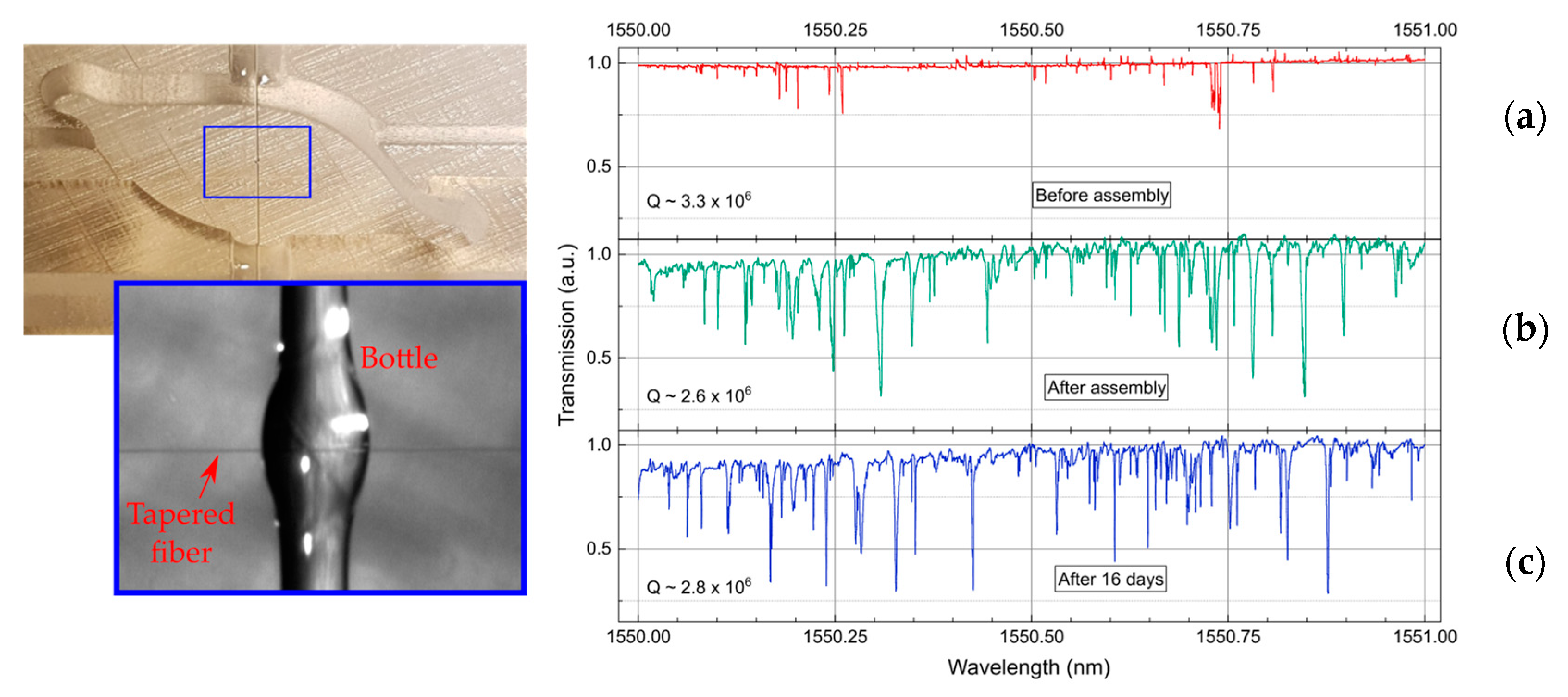
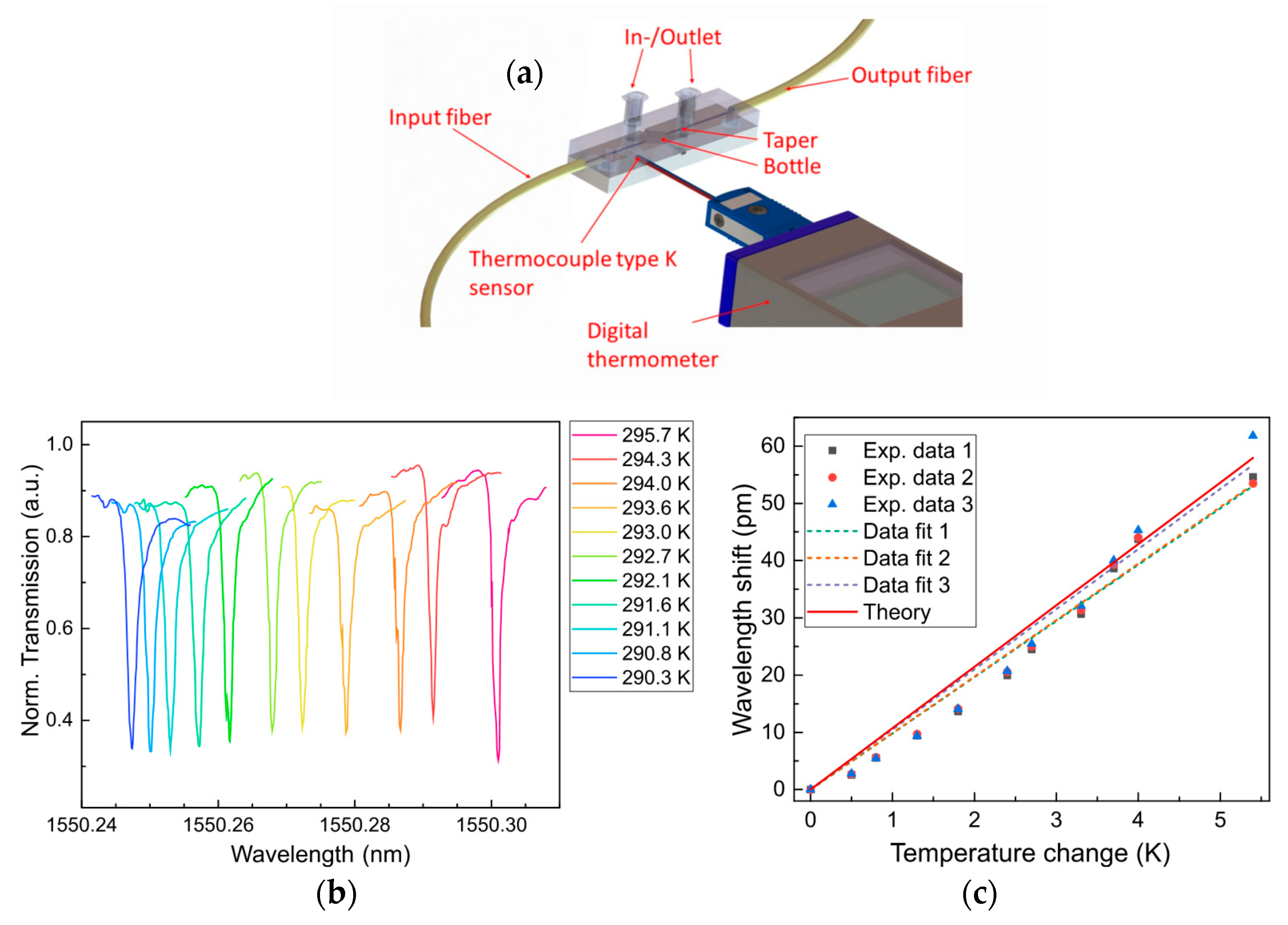
| Position at z (µm) | (m, p, q) TE | (m, p, q) TM |
|---|---|---|
| 0 | (519, 1, 0) | (519, 1, 0) |
| 110 | (435, 1, 175) | (436, 1, 176) |
| Experimental FSR (nm) | Theoretical TE FSR (nm) | Theoretical TM FSR (nm) | |
|---|---|---|---|
| FSRazimuthal,1 | 2.892 | 2.911 | 2.911 |
| FSRazimuthal,2 | 2.902 | 2.921 | 2.921 |
| FSRazimuthal,3 | 2.916 | 2.933 | 2.933 |
| FSRazimuthal,4 | 2.892 | 2.912 | 2.912 |
| FSRazimuthal,5 | 2.903 | 2.924 | 2.923 |
| FSRazimuthal,6 | 2.916 | 2.935 | 2.935 |
| FSRaxial,1 | 1.3212 | 1.322 | 1.317 |
| FSRaxial,2 | 1.3248 | 1.324 | 1.321 |
| FSRaxial,3 | 1.3266 | 1.320 | 1.315 |
| Wavelength (nm) T = 294 K | Q T = 294 K | Sensitivity (pm/K) | Limit of Detection (K) | |
|---|---|---|---|---|
| 1 | 1550.1723 | 7.28 × 105 | 9.8 | 0.22 |
| 2 | 1550.2867 | 1.25 × 106 | 9.9 | 0.13 |
| 3 | 1550.6165 | 2.58 × 106 | 10.5 | 0.06 |
© 2018 by the authors. Licensee MDPI, Basel, Switzerland. This article is an open access article distributed under the terms and conditions of the Creative Commons Attribution (CC BY) license (http://creativecommons.org/licenses/by/4.0/).
Share and Cite
Herter, J.; Wunderlich, V.; Janeczka, C.; Zamora, V. Experimental Demonstration of Temperature Sensing with Packaged Glass Bottle Microresonators. Sensors 2018, 18, 4321. https://doi.org/10.3390/s18124321
Herter J, Wunderlich V, Janeczka C, Zamora V. Experimental Demonstration of Temperature Sensing with Packaged Glass Bottle Microresonators. Sensors. 2018; 18(12):4321. https://doi.org/10.3390/s18124321
Chicago/Turabian StyleHerter, Jonas, Valentin Wunderlich, Christian Janeczka, and Vanessa Zamora. 2018. "Experimental Demonstration of Temperature Sensing with Packaged Glass Bottle Microresonators" Sensors 18, no. 12: 4321. https://doi.org/10.3390/s18124321
APA StyleHerter, J., Wunderlich, V., Janeczka, C., & Zamora, V. (2018). Experimental Demonstration of Temperature Sensing with Packaged Glass Bottle Microresonators. Sensors, 18(12), 4321. https://doi.org/10.3390/s18124321




